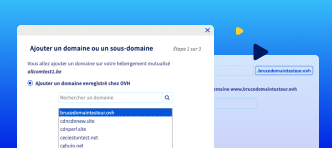Domain transfer
Transfer your domain name securely


Transfer in three steps
You can transfer your domain name to OVHcloud in three simple steps: first, disable the transfer lock, then search for the domain in our tool, and finally, enter the transfer code from your current provider. We take care of the rest.
15 GB email and DNS protection included
Each transfer includes a personalised 15 GB email address linked to your domain, for professional communication with your clients and partners. We also automatically enable DNSSEC, a technology that ensures your visitors reach your website and not a fraudulent version.


Centralised management and clear pricing
Consolidate your domain names with OVHcloud to manage everything from one interface: renewals, redirects, subdomains, DNS zones, and associated emails. Transparent pricing keeps your budget predictable, with no unexpected costs at renewal.
Assistance and support
To complete your domain names

Web hosting
Comprehensive packs tailored to all your web projects.
Expand your online presence with our web hosting plans, which include a free domain name for the first year*, and mailboxes.
Your questions answered
How long does it take to transfer a domain name?
On average, transferring a domain name takes five days. The timeframe varies depending on the current registrar and the specific extension. This process validates and confirms the holder’s information. In some cases, an agreement given directly by email can cut the time down to minutes.
Can I speed up the transfer process?
Depending on your current provider, you can approve the registrar switch in two ways:
- from the OVHcloud Control Panel, by directly validating the request;
- or by clicking the approval link sent to the holder’s email address, as shown in Whois.
Sometimes this manual validation speeds things up, reducing the time from several days to just minutes. As a result, some extensions managed by the Internet Corporation for Assigned Names and Numbers (ICANN), such as .com, .net, or .org domains, can be transferred much more quickly.
How much does it cost to transfer a domain?
The transfer price often covers an additional year of validity, in line with the terms of the applicable extension registry. The price varies depending on the extension, but OVHcloud is always transparent about pricing, with no hidden fees or subsequent surcharges. You can also check the available options when buying a domain name.
Please note that consolidating your domain names with a single registrar simplifies the management of your DNS services and web hosting.
Can I transfer an expired domain?
No. An expired domain must be renewed with your registrar or current host before you can make any transfer request. If a business relies on internet services, planning for this is recommended to prevent website or email interruptions. You can also reserve a new domain name directly with OVHcloud.
What could cause my transfer to fail?
There are several reasons why a transfer might not work:
- the domain was created or transferred within the last 60 days;
- it is locked by the original registrar;
- the authorisation code (auth or EPP) is not valid;
- the domain is expired or suspended.
You can use either the Whois service or its replacement, the RDAP protocol, to view the status and details of your domain name. Ensure your authorisation code is valid before starting the switch. If necessary, contact your current provider directly.
How do I obtain my transfer code (auth code)?
The transfer code (also known as authorisation code, domain auth code or EPP code) is provided by your current registrar. Depending on the provider, it may be accessible in your user area or given to you by the support team. This transfer key certifies that you are the domain’s legitimate owner and allows the switch to OVHcloud.
Should I unlock my domain before starting the process?
Yes. Some registrars lock domains by default. Before you begin the transfer process, be sure to disable this lock and get the validation code. This step is necessary for the switch to be approved.
What should I do if my host or provider blocks the transfer?
Some registrars or hosting providers lock domains by default for security reasons. In this case, you need to disable this lock in your current user area and get the authorisation code. Once the domain is unlocked, you can safely begin the transfer to OVHcloud.
Can the domain’s owner be changed during the transfer?
No. The transfer is solely about switching registrars. The transfer of legal ownership is a separate step, available to you once the domain is active in your OVHcloud Control Panel.
Can I transfer all domain extensions to OVHcloud?
OVHcloud supports several hundred extensions: generic (.com, .net), specialised (.shop, .tech) and geographical (.uk, .eu). This option allows both businesses and individuals to centralise the management of their domain names.
At the same time, OVHcloud is committed to a sustainable digital approach, balancing security, sovereignty, and environmental responsibility.
What happens after a successful transfer?
Once the procedure is complete, your domain will appear in your OVHcloud Control Panel. You can then manage your DNS, configure redirects, create new email addresses, and set up incoming mail servers (IMAP/POP). You also have the option to link your domain to a web hosting plan, a virtual private server (VPS), or even a dedicated server, depending on your needs.
How does OVHcloud protect my data during a transfer?
We apply DNSSEC protection by default on most compatible extensions. This solution limits the risk of hijacking and strengthens the security of your communications. Your data, like that of your clients, remains private and protected.
Can I register a domain online without going through a third party?
Yes. You can check if your domain name is available using our online tool (domain availability check). Once the name is chosen, the creation and registration process is handled by OVHcloud, skipping the need for another provider or registrar.
How do I register a new domain name?
To register a domain name, you’ll need to ensure it hasn’t already been reserved by somebody else. Go to our search tool, enter the desired domain, and choose your extension. If it’s available, the next steps are to order and then register it in either your name or your company’s. OVHcloud then takes care of the technical and administrative management of your domain.
How do I set up my emails after registering a domain?
You can add custom email addresses once you’ve registered and activated your domain. You can also configure your incoming mail servers (IMAP or POP) in your email application to receive messages. This gives you full control over your work-related communications.
How do I renew a domain name?
A domain name should be renewed before it expires to avoid service interruptions. You can do this manually in your Control Panel or enable automatic renewal for your convenience. The price then depends on the chosen extension. See all the steps in our renewal guide.
How do I know if a domain name is available?
A domain might appear inactive despite already being reserved. To check its availability, use our Whois service or the RDAP protocol. There are three possible scenarios:
- buy: you can register it;
- unavailable: the registry may be carrying out maintenance on the domain name extension—you can try again later;
- transfer: you can transfer it to OVHcloud.
When choosing your future domain, also check with the INPI to confirm no other company has already registered it. You can then secure your online identity, both as a domain name and as a trademark.


